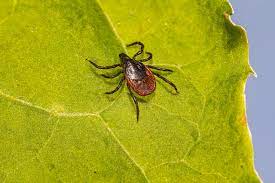Lyme borreliosis is a bacterial disease that is transmitted to animals (horses, dogs, humans, and often to cats) through tick vectors. Lyme borreliosis is also known as Lyme disease. It is caused by Borrelia burgdorferi (Bb) that is a spirochete bacterium. This disease is also reported in other mammalian and avian species as they become infected but they do not manifest clinical signs of the disease.
Borrelia Burgdorferi is the most important pathogen for domestic animals. Borrelia is transmitted through the blood meal of ixodid ticks. Borrelia is not transmitted through physical contact with insects, and the transfer of saliva, semen, urine, or bite wounds. Rodents contribute as a major part of reservoir hosts. Birds and lizards also harbor certain species of borrelia and act as reservoir hosts.

Clinical Signs
Borrelia burgdorferi is a “stealth pathogen” as it can take weeks to months to develop the signs of disease after the bite of tick(s). Unlike other viral infections (Distemper and Parvovirus), it has an incubation period of about 50 to 160 days. Some species of the dog (Labrador, Golden Retriever, and Bernese Mountain) are more prone to a fatal form of neuropathic Lyme disease due to their genetic makeup.
In dogs, a number of clinical syndromes are attributed to Lyme borreliosis.
1. Lameness due to arthritis (Recurrent or intermittent lameness)
2. Fever
3. Anorexia
4. Lethargy
5. Lymphadenopathy
6. Joint/limb swelling due to inflamed synovial membranes
Renal failure is the second syndrome which is often fatal. It is characterized with
1. Uremia
2. Hyperphosphatemia
3. Protein losing nephropathy
4. Peripheral edema
Neurologic form is characterized with
1. Facial paralysis
2. Seizure disorders
Prevention
The strategy adopted to counter this disease is represented with the acronym V.E.T. It stands for Vaccinate –Educate – Tick Control. All these components are pertinent to prevent this disease. Developed countries have vaccines available for the prevention of Lyme disease. Along with following a proper vaccination schedule, Use of quality tick control products is also essential. Pet owners should also be educated about the seriousness of the disease and how to manage, avoid and remove ticks from their pets and the yards.
Two types of vaccines are commonly used for Lyme disease. 1st type of vaccine contains multiple whole cell bacterial antigens and adjuvant. While the second type of vaccine contains a purified recombinant subunit of OspA (vulnerable outer surface protein of bacteria). Both types of vaccines, protect the animal based on their ability to generate antibodies against OspA in the vaccine recipient.
Diagnosis
In Lyme borreliosis, all affected dogs do not show signs of disease. It is reported that about 5-65% of dogs show their clinical signs of illness after they are infected with Borrelia burgdorferi. Two types of methods are commonly used for the detection of Borrelia burgdorferi.
1. Direct Methods
2. Indirect Methods
In direct methods, techniques of PCR and culture are used for the detection of Borrelia burgdorferi from tissue samples. These methods are rarely conducted in the practice due to their cost, time, and invasive nature of sampling (biopsy). These methods are very good when they are conducted in quality laboratories.
Indirect methods are those methods in which antibody detection is performed. Western blot and other related techniques are adapted for this purpose. These methods are easier, less costly, and less invasive as only serum or blood sample is required for performing these techniques.
When antibodies are detected, the dog should be evaluated regarding its living area. If in that particular geographical region, black-legged ticks are found then the test result will be surer. If the tick is observed rarely in that region then it will create suspicion on the resulting authenticity. In such a condition, a confirmatory test should be conducted on that sample.
Treatment of lyme borreliosis
The traditional time period for treatment is 4 week.
1. Tetracycline (doxycycline 10mg/kg, bid, PO)
OR
2. Penicillin (amoxicillin 20mg/kg, tid, PO)
(Dogs exhibiting the clinical signs of synovitis/arthritis are recommended to treat with doxycycline or amoxicillin)
3. Cefovecin (semisynthetic cephalosporin) has been reported to be efficacious against Borrelia burgdorferi. (8mg/kg)
Provide supportive therapy depending upon clinical signs.


